There’s something undeniably brilliant about, at least, the concept behind Deadpool: the Game. In most every modern 3D video game, you play as a badass white dude who is an expert at every weapon he encounters, regenerates his body in a way that makes him essentially indestructible, and mercilessly massacres other men by the hundreds. In High Moon Studios’ Deadpool, I play as Deadpool. Take that, ludonarrative dissonance! Love it or hate it, Deadpool is at least the most honest third person action game in this console generation.
Unlike a lot of people who have reviewed this title, I am a Deadpool fanatic. I have comics and posters and T-shirts and statues and original signed art. I know it’s wrong to say “I liked it before it was cool” but I’ve been collecting Deadpool swag since 1997 and this is one case where I can never apologize. I’m a scary person when the topic of Deadpool comes up. I have an illness, a mania. I’ll talk the ears off of random strangers for hours at the slightest prompt and find myself unable to stop. Most people know Deadpool as “that character that breaks the fourth wall all the time,” and while that is true, it’s actually an inaccurate representation of the character overall. There’s more to it than that. Those who say Deadpool is a one-note character are wrong. He just needs the proper supporting cast and a writer with the chops to explore the character’s serious and silly sides in the proper ratio.
That writer was not Daniel Way, yet that’s the man who was asked to pen the script for the Deadpool video game. The problem with the writing in Deadpool, the Game – and the writing is critical to the thing working at all – is that it never takes a second to breathe. Deadpool is actually a pretty dark character. His origin story is that he went to Weapon X, a secret government Black Ops science program, out of desperation because he was dying of cancer. The healing factor that was implanted in his body gave him the healing powers of the more-famous Wolverine, but the cancer spread anyway, turning his entire body into a living cancerous scar. You can see this in the game whenever he removes parts of his uniform, or when it rips. People call him a “freak,” as they should. Number of times the word “cancer” actually shows up in the videogame: zero.
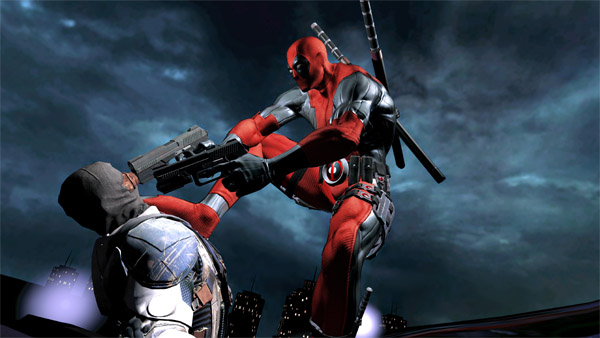
I’m not a fan of the conceit that, in order to seem crazy enough, Deadpool needs to have multiple personalities that manifest as voices in his head. This was never part of the character in the classic comic series, but it’s present here, the Screwball Deadpool and Serious Deadpool given some screentime in internal monologue that manifests in on-screen word balloons. Serious Deadpool is not very serious in the way that cancer is serious. Deadpool is voiced, as in Marvel Vs. Capcom 3, by Nolan North. He does well enough with the material and playing off himself (at one point, literally himself), but I’ve never seen Deadpool voice-cast in a way that reminded me of the way he comes off in the books. I know some things work in print that just don’t when animated, so I can’t really complain about the casting. Mostly I’m complaining the writing could’ve been, not necessarily sharper, but better paced, with a few downbeats to contrast the comedy properly.
As an illustration of how this is all a little off, I want to talk about the use of Patsy Cline in this game.
I first encountered this in the Giant Bomb Quick Look, before I even got the game home to play for myself. The first level of Deadpool the Game is building with an office and a penthouse apartment. This is a perfectly-Deadpool level to explore and suits the character and his place in the world just fine. The objective for the level is to get to the top of the building to take out a mark Deadpool’s been hired to kill. Wave upon wave of goons are sent against him, and merciless slaughter ensues. After completing a few objectives, Deadpool is greeted with an elevator. Deadpool gets on the elevator. The song “Crazy,” by Patsy Cline, plays over the elevator speakers. Deadpool says “this is my song,” and, he happily sings along.
So… I first assumed this was done out of ignorance. How that could’ve possibly happened, I didn’t know, but it made actually me feel as if I’d been hit in the stomach. I had to pause the video and breathe. If you’re going to license one outside song for a Deadpool videogame, yes, “Crazy” is the one to choose. It’s absolutely Deadpool’s song. It might be more accurate to explain that it’s Deadpool’s love theme. You know, I’ll just go ahead and let Wade explain:
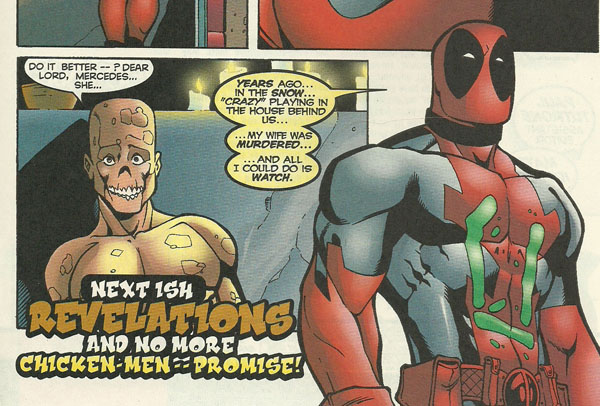
That’s “his song” because it might have been playing when his wife died.
So Deadpool should, in a well-written world, have a slightly more complicated relationship with that song than just… blissfully singing along.
Now that comes from one of the stranger Deadpool stories, a story that, while it was never explicitly retconned, was never not retconned either. It also, as you can see, had a chicken man. Comic books are weird. But I’m pretty sure that the creators of Deadpool the Game were aware of the story, because, in a later segment involving the Death character, a panel from that exact story is flashed on screen. And the song is re-used in the game again, in a slightly better context but in a way that still misses the mark. It lacks any kind of respect or gravity. It references a pretty contentious and dark plot-point from over a decade ago in service of a wacky gag. It’s symbolic of how, in ignoring the character’s heart, the Deadpool Game is also leaving behind what’s ultimately interesting about the character and what, in a larger context, makes him actually work. Deadpool could be beautiful but he’s ugly; he could be funny, but he can be pretty damn annoying.
We’re going to spend eight to ten hours with this guy – the length of the game generally depending on how deep you plum it. That’s longer than a movie, and I’m pretty sure that a movie would at some point touch on, say, the whole cancer thing, at the very least. This character has some nuance and in a starring vehicle for him we could’ve explored that. He’s crazy – crazy – but why?
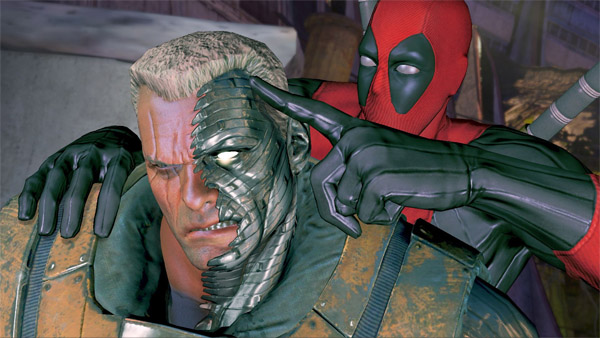
It’s not to say that the funny parts aren’t funny. There’s some solid gags during cutscenes in this game. Cable shows up (and if you don’t know who Cable is, god help you, because the game explains it with a quick gag reel which though it made me laugh is very unhelpful), and the banter with him is pretty spot-on. There’s some funny interactions with Wolverine. I can hit on girls and get roundly rejected, which pleases my inner Larry Laffer. There are a lot of dick jokes; some work and some don’t. I’m a Saints Row fan but yet I thought the penis jokes in this game started to get a little much. I think Deadpool is possibly the first superhero videogame in which the titular hero spends time drawing attention to anatomically correct rendering. I can only imagine the backroom conversations this caused during the development process.
Humor outside of cutscenes works less well. When one is making a superhero game, the main question to ask is, “What’s the fantasy of being this character?” For example, in the Arkham games, Rocksteady asked “What’s the fantasy of being Batman” and came up with a really cool stealth system that allows him to confuse and frighten the bad guys. The fantasy of being Deadpool is really straightforward and, as I mentioned above, suits a modern video game so well that it’s a no-brainer. It’s the fantasy of mowing down hundreds of henchmen in gory, violent ways while firing off non-stop nonchalant clever banter. In game design terms, that banter has to be manifested as lots of little sound-drops whenever Wade kills someone, or they damage him, or he shoots at them, etcetera. This means that you’re destined to hear a lot of the same barks over and over again, and that sometimes they’re going to be mis-timed or overwrite each other. Some of these lines are just there to fill air. Others are funny the first time but not so much the eighth time.
The level design in this game is just… weird. There’s some levels that seem developed just in service to the humor. There’s others that seem like they just fell out of some other game. The nearest comparison that I would make is Duke Nukem Forever. That sounds really damning and I guess it is. But Duke Nukem Forever was at least a fascinating accident, a mish-mash of design theories from multiple decades all pulled together to create a title born out of nostalgia and desperation. I don’t know why anyone would ape it on purpose. But here you have it. At least there are no forced vehicle sections.
In Deadpool the first actual level is Deadpool’s apartment, where, in DNF style, a player can choose to mess around with various environmental objects and get a comedy beat. Among these objects are a toilet that you can choose to poop in. You must do this if you want the Trophy/Achievement for full apartment exploration. So Deadpool is a game where you drop trou in the first level, it’s not pretty, and if you do it there’s an Achievement in it for you. There’s also a mirror you can look in, where Deadpool shows his face and how amazingly disgusting he looks. This might’ve been an okay time for the game to give some backstory about why he looks that way (cancer cancer cancer) but, no time for that, there’s dick jokes to make and we only have eight hours!
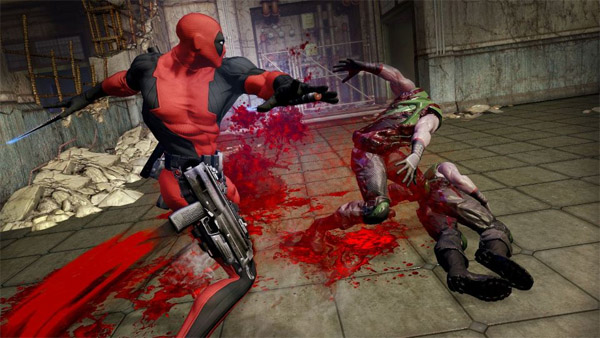
The first action level, the office building, is a good tutorial to the game’s combat systems. This is followed by the perhaps-requisite sewer level. (This is is where I feel the need to point out once more that if something is a cliché, commenting on how it is a cliché does not make it not a cliché; see also Retro City Rampage.) The majority of the game is then spent on the island of Genosha, in a series of mostly-destroyed prison complexes. This isn’t a terribly interesting environment from a visual perspective. The bits of broken Sentinel robots, which you have to interact with, are the only really unique environmental assets. The rest is pretty standard-looking stuff that could’ve been in any other game.
I’m not the sort of reviewer to say “This game was awful; AND, it wasn’t long enough – minus points!” So let me assure you that despite the game actually being less than ten hours, the Genosha levels go on, by my estimation, for about sixteen weeks. Deadpool spends a lot of this time trying to rescue X-Woman Rogue, who is damseled for reasons that are not really clear. The game skips over a lot of exposition by explaining that Wade himself isn’t really paying attention to it. This is another element of the game that could be made to work, but doesn’t really.
The game’s villain is Mister Sinister. Sinister makes clones of himself, which gives the game a good excuse to throw hundreds of mostly-identical enemies at Deadpool. Enemies are fought with a free-flowing combo-based melee/gadget system – like in Arkham City – and, when an enemy is about to attack, they get a little indicator over their head so you can press the Counter button – like in Arkham City. Where it differs from the Arkham games is that lots of enemies have ranged weapons and have no problems firing into melee. Unlike Batman, Deadpool can survive bullets, but he can’t do that forever. So you might want to track down and eliminate those enemies first … except some enemies have shields over their heads which indicates they’re making other enemies invincible, so you need to eliminate those guys first … except some enemies have heavy chainguns and weapons that would make the encounter much easier, so eliminate those guys first… Really, the best strategy is to separate the guys and get them stuck on as much geometry as possible, so you have some cover from people shooting at you while you try to strategically figure out who to pick off in what order. It ends up feeling a bit glitchy. Deadpool’s dodge move is actually a miniature teleporter, but it’s effectively a dodge roll because he can’t teleport through obstacles or over walls. He can teleport across wide gaps, sometimes, but only when the game is okay with that.
Dudes in this game take a lot of hits to kill at times. This can be countered by upgrading your attacks and weapons and combos periodically (you know, like in Arkham City). This system in Deadpool isn’t very well thought-out, though. No upgrades in the game are plot-triggered; they’re just unlocked whenever you have enough Deadpool Points to unlock them. Deadpool Points are earned by playing the game well, but they’re also scattered all over the environment like some sort of 90s-era Rare collectable. This is all-round bad, because, the best way to get Deadpool Points is by killing guys more effectively, but Deadpool Points are needed to unlock the upgrades that allow you to kill guys more effectively. This might be okay if it were clear what actions lead to more points or if I didn’t lose points when I got hit, but as-is it leads to positive feedback loops pretty quickly. You can also upgrade your ability to get Deadpool Points, which you should probably do, since new weapons cost sometimes up to a hundred thousand Deadpool Points. It’s a mess.
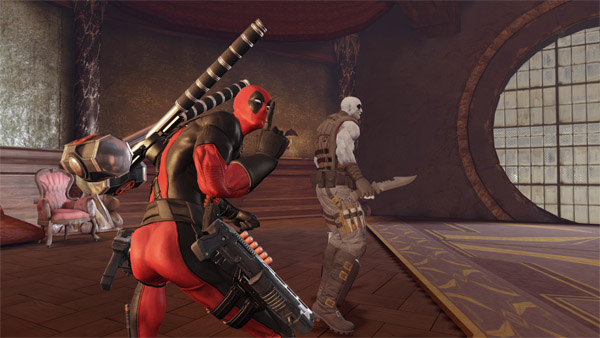
Once all the weapons are unlocked combat can actually be really fun. Switching between weapons during a free-flow combo is seamless. Deadpool can pull out his guns and shoot people in the middle of a melee combo, sometimes behind his back or over his head without even looking. That’s glorious. The guns, sadly, have limited ammo. The ammo is specific to each gun, it’s scattered around everywhere, and all ammo icons look the same until you’re up close. The game doesn’t track which guns you’ve bothered to unlock, so sometimes you’ll trek across a map just to discover that ammo is for a gun you haven’t even unlocked yet, or for a gun that’s full, so you’re stuck trying to use the shotgun on a faraway enemy because it’s the only gun you have with ammo still in it, at which point Deadpool calls you a noob.
Deadpool can stealth-kill guys, but these segments are environmentally triggered. There’s no button I can push to sneak up on someone. Wade just goes into a very broad, cartoonish sneaking animation sometimes, and that indicates “this is a stealth segment now.” The stealth executions are gross and cool. I wish I could do them whenever I wanted.
It seems like for every good thing I’ve found, I end up talking about a bad thing instead. I went in with pretty low expectations and while I didn’t hate all of the experience I don’t think I want a second helping, either. There’s a segment of the game where Deadpool is instructed, in helpful mission text, to “find his totally real fangirl” somewhere in the level. There of course is no fangirl in the level. Alas – she does exist – but she was holding the controller and was forever beyond his reach. Tragedy! Yet, I know that I yelled “shut the fuck up, Wade” enough times at the screen during this experience that I probably also qualify now as a member of his Rogue’s Gallery. Reviews across the board for this one have been pretty bad, so I don’t think this is being considered as further franchise material. But, High Moon Studios, if you do intend to do any other Deadpool title in the future, I am available for consultation. Just sayin’.
![]()
Developer: High Moon Studios | Publisher: Activision | Released: June 2013
Available on: PC, XBox 360, PS3 (played on PS3) | Time Played: 10 hours
![]()
Email the author of this post at aj@tap-repeatedly.com.


Hmmm.
Well I won’t lie, AJ, I got a definite sense of ambivalence from you about this game. Not about Deadpool, but about his game. Definite sense of ambivalence.
My experience with comics and graphic novels is depressingly minimal, something I know rightly damages my geek cred. I read Batman for a while in my youth, and now I have a good friend who shares all the best comics with me. The positive of this is that whatever I read is Ajax19-approved, meaning it’s almost certainly awesome. The downside is that I’m not actually learning anything. It’s like having a parent help with my homework. Ajax does all the heavy lifting.
I’d like to see comic games be more than what this one appears to be, though. More than tired nods to franchise, handed to a mediocre developer to check a box. I think we were all so surprised by Arkham Asylum because nobody expected it to be any more than that (Rocksteady’s history certainly didn’t imply that it would be), and then… Arkham Asylum. But for every one of those there are a million Deadpools, just plain-jane, medium-rare games that are memorable mostly for being forgettable. Which is depressing especially because you’ve got someone like AJ here, an unabashed fan, who goes in wanting to give the game the benefit of the doubt. Wanting to be impressed, or at least not disappointed. Instead we as readers lucked out because we got this hilariously awesome review, but AJ kinda got the shaft because not only did she have to play the game, she didn’t get the game she wanted.
I sure am glad you’re able to maintain a sense of humor about this stuff, AJ!
Well it’s not all bad, I did have a great conversation with the hubby about how it could’ve been twenty times better on the same budget with just a pretty basic narrative tweak.
I don’t really think High Moon is a mediocre developer. They’ve done good stuff with Transformers. Which I’m also a giant, unapologetic fan of.
Well, let’s get into this Amanda, Steerpike.
Who is a licensed IP game really for? I hear arguments that “well, [game X] can’t be a total fanboy fest because it won’t make sense to people outside of the fandom”. But if that’s the problem why appropriate the character/franchise in the first place if not to capture your fandom? If you’re going to make a Transformers game, why make it so generic that it’s barely a Transformers game?
Licenses seem to be used to *increase* rather than *target* audience, which often translates into the bland mish-mash we normally associate with license games.
Again, looking at it from the point of the licensor, are Marvel thinking the Deadpool game will expand their Deadpool audience? If that’s true, playing the long game rather than the profit motive – that has implications for the game design too.
I sorta feel like the game was for people who knew a bit about the character but aren’t as deep into him as I am. Know too much, and you’ll be frustrated, know too little, and you’ll be lost.
There’s a conversation fairly early on where Deadpool says something like “I wonder if the player knows anything about me… well, I guess if they bought the game…” (only if I recall correctly it’s like a conversation between two of his “voices” because he’s craaaaaazyyyyy)
I know nothing about Deadpool and care even less. That said, you should take the super-opinionated tack more often. It’s entertaining and it suits you. 🙂
Thanks! Wait, am I not usually super-opinionated? I’ll have to work harder at that 🙂
Hmm, you’re right and I stand corrected. Maybe your obvious passion for the source material just made it more apparent.
This review captures what disappointed me about Deadpool much more eloquently than my own review did, so I’m going to feel bad about that for a second now.
You’re spot-on, of course: Deadpool is way more complicated character than people give him credit for. And it’s really weird to see that the Deadpool developers seem to know this — remember how the dialogue in the Killebrew section of the Tunnel of Death was pretty much completely correct? — they just choose to not do anything with it. Not even so much as a Weasel to handle your upgrades.
Still, I guess it’s a step in the right direction from Wolverine Origins.
@Jarenth – Exactly! Augh. The omission of Weasel was so ridiculously glaring. Weasel would’ve fixed things A LOT by being the “voice on the radio” for you, and also being the guy who drops upgrades for Wade so there’s a plot reason for them happening and they are reasonably tiered rather than through a menu. The omission of that character is absolutely glaring. It’s enough to make me think that there was some kind of rights issue or something; I don’t know. Weasel WAS in Ultimate Alliance series so it isn’t like he’s never been in a game before. It feels a lot like this game just forgot about him, when having a guy whose job is *literally* “Deadpool’s weapon supplier” would’ve solved maybe 70 percent of this game’s flow problems.
I’m angry just thinking about it, all over again. Ha ha. Also agreed on the Tunnel of Death section. It’s like they knew but then kept forgetting.
Or maybe they’re pulling a rare and enviable double meta, setting this game in one of the time periods where Wade and Weasel weren’t on speaking terms.
You don’t know, it could happen!
This is very late, but, had my suspicions confirmed today: Weasel wasn’t in it due to licensing.
The blame therefore rests on Marvel.
That was dumb, Marvel – what were you saving him for?
[…] https://tap-repeatedly.com/2013/07/review-deadpool/ […]